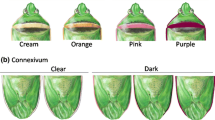Abstract
The dried peripheral area of pond Idumban (62 ha) increased from 3.2 ha in January to 3 1.9 ha in April. Pila globosa, which were abundant in the littoral area, did not commence aestivation during this period, perhaps due to low temperature and/or high dissolved oxygen content. The number of aestivating snails averaged 0.5/m2 in May, 1973 (3.6% of the total population) and it increased to 1.1/M2 in September (26.2%). Biomass of the snail increased from 3.5 to 19.9 g dry weight (including shell)/M2. Number of aestivating snails increased from 0.4/m2 (5.2% of the total population) in May 1974 to 0.8/m2 (11.1%) in July and the biomass from 4.1 g/m2 to 10.7 g/m2. Availability of dried area for aestivation increased from 5.3 to 23.7 ha in 1973 and from 13.5 to 30.2 ha in 1974.
Monthly observations made on the marked snails forced to aestivate at 7.5, 15.0, 22.5 and 30.0 cm depth in the pond during May, revealed that temperature above 35°C and moisture below 5% were critical. Mortality and weight loss decreased in the snails forced to aestivate at increasing depth. Random observations indicated that 83% of the aestivating snails buried themselves at 15 cm depth in the pond. On the whole, 98,480 snails (592 Kg) and 115,270 (758 Kg) died during aestivation in 1973 and 1974 respectively. Of the total weight loss, the energy lost via metabolism contributed only a small fraction of 2.2% (12 Kg) and 2.1% (15 Kg) during these years. Considering the total aestivation area, the snails which succumbed averaged only 0.4/m2/year (2.5 g/m2/year). On an average, dry substance equivalent to about 2.6 mg dry weight/ g dry weight of snail/ day (3.7 gcal/ g live snail/ day) was lost on metabolism by the aestivating snails, i.e. the metabolic level of the aestivating snail was about 1 / 18th of that of the actively feeding snail.
Similar content being viewed by others
References
Anjani Prasad, C. & Krishnamoorthy, R. V. 1962. Catalase activity in normal and aestivated snail Ariophanta sp. J. Anim. Morph. Physiol. 9: 41–45.
Bernice, R. 1972. Ecological studies on Streptocephalus dichotomus Baird. Hydrobiologia 53: 39–58.
Clements, A. N. 1963. The Physiology of mosquitoes. p. 393. Pergamon Press, London.
Coles, C. C. 1968. The termination of aestivation in the large freshwater snail Pila ovata (Ampullaridae). I. Changes in oxygen uptake. Comp. Biochem. Physiol. 25: 517–522.
Coles, C. C. 1969. The termination of aestivation in the large freshwater snail Pila ovata. II. in vitro studies. Comp. Biochem. Physiol. 29: 373–381.
Das, B. K. 1927. The biology of certain air-breathing fishes of India, together with an account of the development of their air-breathing organs. Phil. Trans. Roy. Soc. 216: 183–219.
Eckstein, B. & Abraham, N. 1959. Succinic dehydrogenase activity in the aestivating and active snails (Helix) Levantina hierosolyma. Physiol. Zool. 32: 210–212.
Engelmann, F. 1966. Energetics, terrestrial field studies and animal productivity. Adv. ecol. Res. 3: 73–115.
George, J. C. & Desai, B. N. 1954. On the liver fat in Pila globosa Swainson). J. Anim. Morph. Physiol. 1: 56–58.
Haniffa, M. A. 1975. Ecophysiological studies in a chosen gastropod. Ph. D. Thesis. Madurai University, Madurai.
Haniffa, M. A. 1977. Secondary productivity and energy flow in a tropical pond. Hydrobiologia (in press).
Haniffa, M. A. & Pandian, T. J. 1977. Morphometry, primary productivity and energy flow in a tropical pond. Hydrobiologia 59: 23–48.
Hyman, L. H. 1967. The Invertebrata. Vol. VI, Part I. p. 1015. McGraw Hill, New York.
Krishnamoorthy, R. V. 1968. Hepatopancreatic unsaturated fatty acids during aestivation of the snail, Pila globosa. Comp. Biochem. Physiol. 24: 279–282.
Meenakshi, V. R. 1956. Physiology of hibernation of Pila. Curr. Sci. 25: 321–322.
Meenakshi, V. R. 1957. Anaerobiosis in the South Indian apple snail Pila virens (L.) during aestivation. J. Zool. Soc. India. 9: 62–71.
Meenakshi, V. R. 1964. Aestivation in Pila. Comp. Biochem. Physiol. 11: 365–368.
Purchon, R. D. 1968. The biology of the molluscs. p. 560. Pergamon press, London.
Raghupathirami Reddi, S. 1965. The changes, properties and metabolism of animals exposed to changed environments. Ph. D. Thesis. Sri Venkatesware University, Tirupathi.
Vivekanandan, E., Haniffa, M. A., Pandian, T. J. & Raghuraman, R. 1974. Studies on energy transformation in the freshwater snail Pila globosa. I. Influence of feeding rate. Freshwat. Biol. 4: 275–280.
Visser, S. A. 1965. A study of the metabolism during aestivation of the amphibious snail Pila ovata. West. African J. Biol. appl. Chem. 8: 41–47.
Wilbur, K. M. 1964. Shell formation and regeneration. in Wilbur, K. M. & Yonge, C. M. (eds). Physiology of Mollusca. Vol. 1, p. 243–282. Academic Press, New York.
Author information
Authors and Affiliations
Rights and permissions
About this article
Cite this article
Haniffa, M.A. Energy loss in an aestivating population of the tropical snail pila globosa. Hydrobiologia 61, 169–182 (1978). https://doi.org/10.1007/BF00018748
Received:
Issue Date:
DOI: https://doi.org/10.1007/BF00018748




